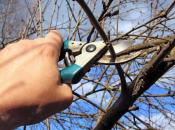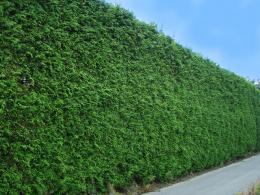Search
Login
Recommended
Do-it-yourself hedge in the country: the advantages of a hedge, planting a hedge, caring for a hedge.
When creating a hedge, you want to protect yourself from extraneous invasion, to hide from the eyes of others and at the same time dream of a beautiful, aesthetic appearance of the future fence. The best option is a hedge.
Content
- Hedgerow, an excursion into history
- The advantages of hedges
- Choosing a type of hedge video
- Planting a hedge
- Ear behind the hedge.
Hedgerow, an excursion into history
The time of the appearance of hedges is not exactly established. It is only known for certain that in England fields and pastures began to be enclosed in this way more than 1000 years ago. Thus, in the Middle Ages, they defended themselves from wild animals, followed grazing cattle, and preserved crops.
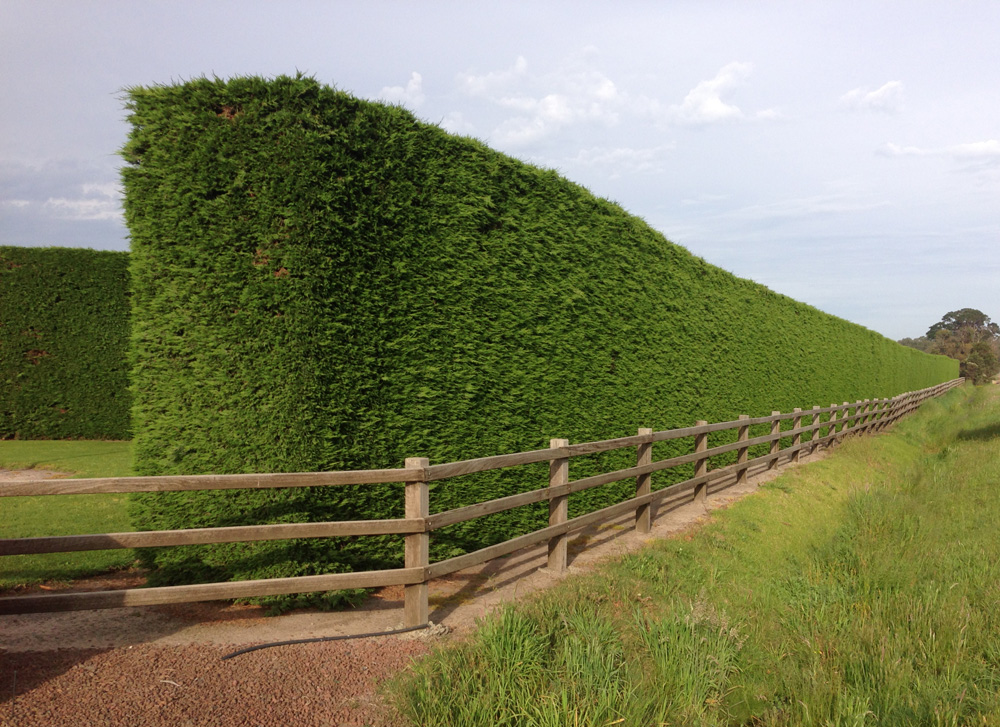
Large landowners, specially laid hedges on their territories - hedges, they gave shelter to pheasants and partridges. With the development of parks, in the early 17th century, hedges became widespread in France, gradually they became one of the most important elements of landscape design.

Dense thickets of trees or shrubs eventually form a solid green wall, thereby not only hiding the inhabitants from prying eyes, but also protecting all cultural plantings from gusts of wind, creating a special microclimate there. Hedgeis the perfect backdrop for ornamental plants.
A properly created hedge is almost impossible to overcome for the invasion of unwanted guests on your site, since it is impossible to climb over a high hedge, and even more so to go through it. The usual fence, no matter what materials it is made of, unless it is energized, is easily overcome.

The British say: properly laid and properly grown hedges are much more durable and reliable than the strongest fences
The advantages of hedges
If you decide to create a hedge on your site, you need to decide why it is needed:

- for a decorative effect;
- for reliable protection of the territory from uninvited guests;

- to create a barrier against wind, noise and dust;
- to create a natural barrier to children and animals, so as not to allow them to get out of the site;
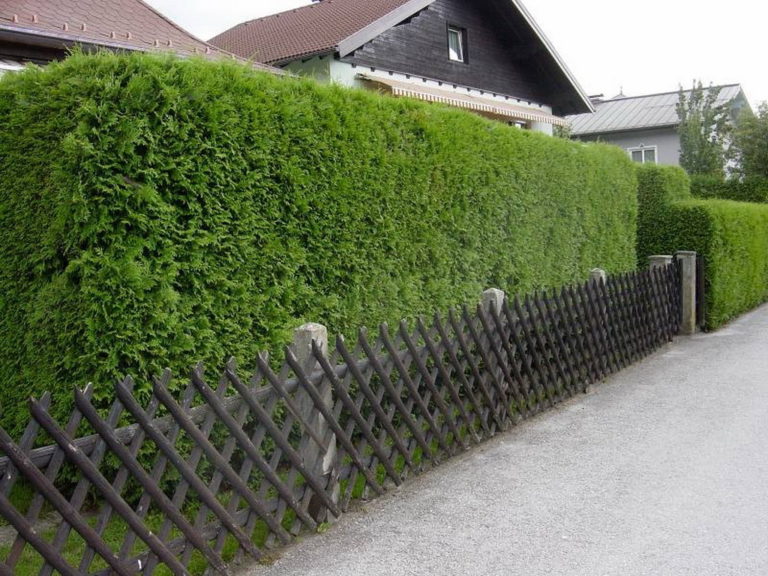
- a combination of several requirements.
Choosing the option, based on the environmental conditions of your site (degree of illumination, groundwater level, soil fertility), you can do the selection of plants. It is necessary to pay attention to whether large trees grow on the site of the future fence.
Since the root system of adult trees is within the growth of the crown, it means that a hedge planted under them will have to fight with a powerful root system for water and food, this will require additional care for enhanced nutrition of shrubs.
If your site is just being developed, the selected place must be cleared of weeds, and if there is a lawn on the site, then the plants are immediately planted in a specially planted trench.
Choice of hedge type
The question arises, what will be the hedge: sheared or freely growing? You need to think ahead, you can cut it yourself, at least 3-4 times per season. Of course, if the money allows, hire a gardener and stop at choosing a cropped shape. For sheared hedges, barberry, hawthorn, privet, cotoneaster brilliant, alpine currant are usually chosen.
Free-growing hedges are planted mainly from flowering or deciduous ornamental plants. However, such landings can be used to divide the site into separate zones, to design resting places and paths.

For such purposes, common or virgin lilacs are planted, mock lilies, honeysuckles, spirea, cinquefoil, tree and panicle hydrangea, three-lobed almonds, Japanese quince, white derain and its motley-colored forms, hawthorn, elderberry and snowberry.
Since these plantings have drawbacks in the form that, over time, the lower part of the trunks will be exposed, it is better to create a fence from plants of different heights, high in the background and lower in front.
When choosing plants for hedges, their decorative properties are taken into account, for example, Tumberg’s barberry, the purple color of the leaves remains throughout the season, and some species of spirae, with the timely removal of faded inflorescences, can bloom up to three times per season.
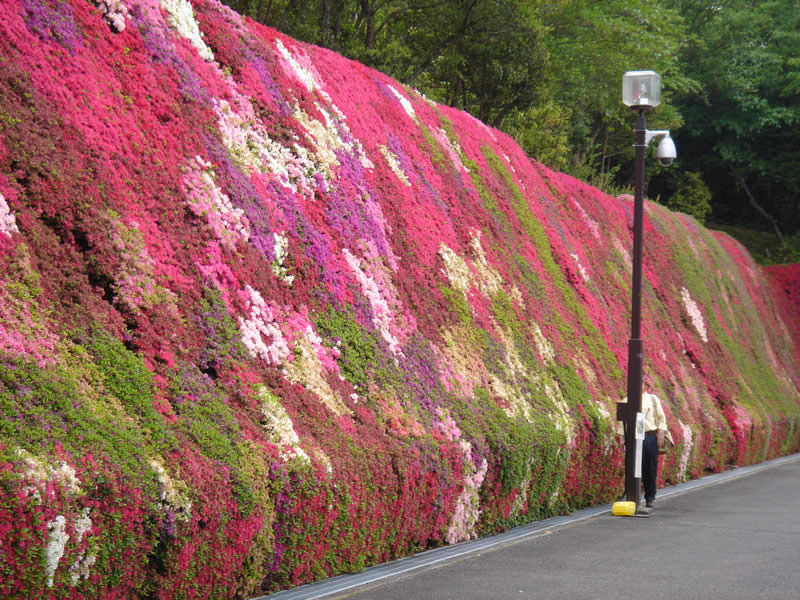
Fences look great when planting deciduous-decorative and flowering plants together.
Effective hedges from one plant species, but with different leaf colors, you can pick plants by flowering time or with a certain color of leaves, alternating them throughout the hedge.
Planting a hedge
They dig a trench 40-60 cm deep along a stretched cord. The width is determined by the number of rows, a single-row hedge is 40-5 cm, 30-40 cm is added to each additional row. The distance between the plants in the row depends on their type and size.
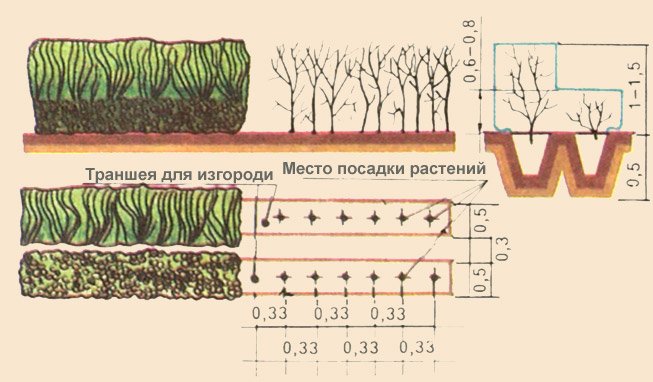
With a single-row planting between the seedlings leave 20-25 cm, lie double row 30-50 cm, it is better to plant them in a checkerboard pattern.
Single-row hedges are created from rocks with dense branching and giving a lot of growth (spirea, hawthorn, alpine currant, etc.).

Double-row - from breeds with loose branching (yellow acacia, sea buckthorn). Before planting, a fertile layer of soil, rotted manure or compost is laid at the bottom of the trench.

The soil around the plants is slightly squeezed, watered, mulched with peat. After planting, seedlings are pruned. The best age of hardwood seedlings for hedges is 2-3 years, conifers - 3-4 years.
Hedge Care
Hedgerows are not created for one year and require special care. They will have to weed, loosen, water, feed with seasonal fertilizers.
Shaped hedges need to be trimmed and free-growing hedges trimmed.

Pruning regulates the growth of free-growing hedges, shearing enhances the growth of side shoots, increases the density of the crown.
In some cases, you can try to combine the fence and hedge, in this case, plants with dense foliage or creepers are used. It’s better to plant adult plants already, otherwise you’ll get tired of waiting until the hedge closes the entire fence.


